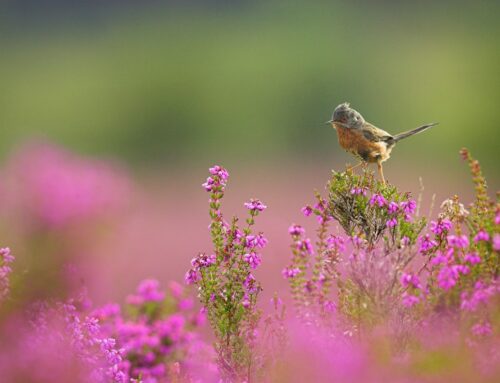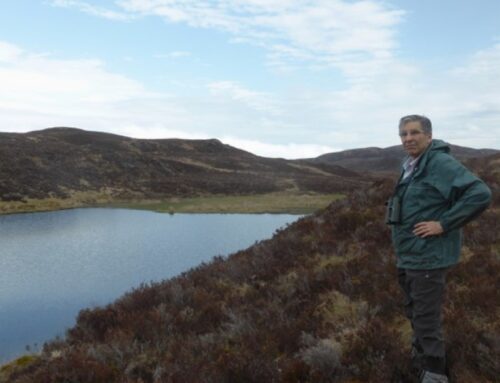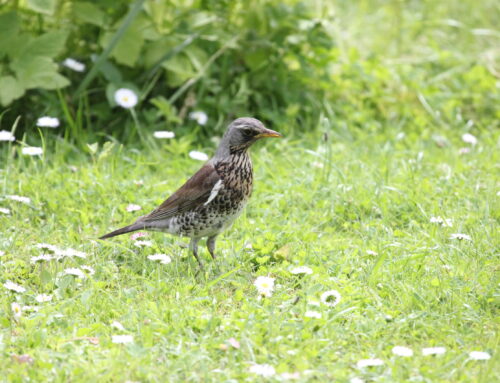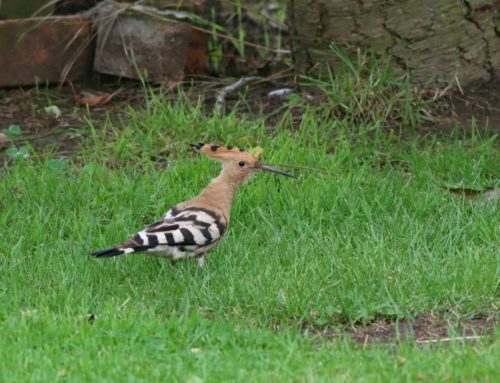What to look for in midsummer

Dotterel, Mark Eaton
As June has progressed into July, the breeding season is at a peak for many bird species, and many more have already produced at least a first brood of offspring. Everywhere you look there should be evidence of birds breeding, with adult birds frantically ferrying food backwards and forwards to nestlings, and young birds waddling, hopping and fluttering around all over. And in the case of later breeders, or birds having moved on to second or even third broods, there may still be singing and displaying birds, such as the Blackcap that has struck up again in my garden after weeks of silence.
Of course, by their very nature rare breeding birds are not to be encountered as frequently or in the numbers of baby Blue Tits, House Sparrows and Starlings, but now is a great time to collect breeding records of a wide range of rare breeding bird species and in many instances “upgrade” records made earlier in the spring from possible or probable breeding to confirmed. The key behaviours to look for have changed since earlier in the breeding season. Courting and territorial behaviour – singing and displaying – will have ceased for many species. Rather, many species will be feeding young, so breeding can be confirmed by seeing adult birds carrying food to nest sites, or (in the case of some passerines) going the other way with faecal sacs. And many species will have, if breeding has been successful, fledged young. This is of course the ultimate confirmation of breeding – but only if there is good reason to believe that the young birds have hatched at the site they were observed and not come from another, unknown, site. This tends to be easy for nidifugous (from the latin nidus, nest, and fugere, to flee) species such as ducks and waders, for which flightless young can be observed, (although see the note for Red-breasted Merganser below). However, caution must be employed if fledged young are observed, particularly if they have reached independence from their parents and for larger and more mobile species – could they have flown in from elsewhere?

Mediterranean Gulls nest colonially and most are on nature reserves, so monitoring coverage is good although some colonies can be difficult to count (photo Mark Eaton).
The Rare Breeding Bird Panel’s species list includes 18 species with UK populations estimated to be in excess of 1,000 pairs, that we define as “less scarce”. As a consequence of their relative abundance, most of these species are under-recorded to a degree, with the exception of three that breed mostly in aggregations at protected sites (Avocet, Mediterranean Gull and Little Tern). Regular readers of these blogs may realise that much of our focus from February onwards has been on encouraging recording of the remaining 15 species, trying to plug the gaps in recording. Mid-summer can be a crucial time for recording some of these species, and I have included notes on recording some of these species below.
Less scarce species monitored by the RBBP:
| Shoveler | Little Tern | Hobby |
| Red-breasted Merganser | Red-throated Diver | Peregrine |
| Turtle Dove | Little Egret | Crested Tit |
| Avocet | Long-eared Owl | Woodlark |
| Greenshank | Lesser Spotted Woodpecker | Dartford Warbler |
| Mediterranean Gull | Merlin | Cirl Bunting |
Although full grown, this preening juvenile Common Pochard is clearly not able to fly yet, confirming that the species has bred at this site in Northumberland (video Mark Eaton).
Mid-summer is the peak time for confirming breeding in Shoveler; like most ducks, finding nests is difficult (and likely to lead to unwanted disturbance) so breeding is best confirmed by observing broods. This is also true for scarcer species such as Wigeon, Pochard and Garganey. Careful judgement may be required when encountering fledged broods – were they raised at the site, or are they more likely to have arrived from elsewhere?
As highlighted in May’s blog, Red-breasted Merganser was only added to the Panel’s list in 2017 and reporting levels are still low – we are very keen to receive more records! In areas where it is genuinely rare, – such as north Wales, northwest England, and my home county of Northumberland – we receive breeding records accounting for most, if not all, of the breeding pairs present. But further north, particularly in north and west Scotland, it is obvious we are only receiving records of a small fraction of the population.

Distant proof of breeding for Red-breasted Merganser, in Shetland (photo Ian Francis)
Although Red-breasted Merganser will breed inland along rivers and on lochs, the majority of the UK population is coastal, breeding in estuaries and sheltered sea lochs. They nest relatively late in the breeding season, with eggs being laid from late May onwards. Nests are usually within a few feet of the water’s edge, hidden away in tussocks of grass and rush, under heather or low willow scrub; small islands are often used. Note, that at particularly attractive sites, pairs may nest in close proximity to each other, and, sometimes, females will egg-dump in another female’s nest leading to extra-large clutches. Ducklings hatch in June and July, fledging by August; so now is a good time to prove breeding by finding broods. Sometimes, broods will combine in large crèches which can make it difficult to determine how many pairs are involved! Note also that they may also move considerable distances after hatching if feeding conditions near the nest are not suitable, looking for locations with calm water and high concentrations of fish fry and aquatic invertebrates.
Although male Turtle Doves may now be spending time less “purring” near nest sites, many first clutches will have hatched so birds will be commuting to and from suitable feeding sites – often some distance from the nest site – feeding young. Any sighting at this time of year will be suggestive of local breeding, so should be reported and better still, followed up to see if a nesting site can be found. Nest sites are usually in dense hedgerows over 4m tall and 4m wide and in scrubland, preferring the protection offered by thorny species such as blackthorn and hawthorn, although at some sites they will nest in other woody habitats such as young conifer plantations.
By now, successful pairs of Red-throated Diver (and the rare relative, Black-throated Diver) will have chicks so breeding can be confirmed. Remember that Red-throated Divers may breed on very small pools on moorland from where they commute to larger lochs and the sea to feed. Also in north and west Scotland, Greenshanks will be reaching the end of their breeding season in areas of open moorland and blanket bog, but parents (particularly males) may still be accompanying offspring although as with the ducks mentioned above, consideration will have to be made as to whether fledged birds may have moved from a breeding site elsewhere.
Totals of Long-eared Owls reported to the RBBP annually by be as little as 10% of the UK population. Their nocturnal behaviour and secretive nature means that breeding pairs can be hard to detect, but the good news is that they can be a lot easier to find in June and July. If they have bred successfully, young birds will be branching out from the nest, or fledging, and beg for food loudly and persistently – the high-pitched “squeaky-gate” call can be heard from considerable distance, and birds may continue calling for hours from dusk onwards. Young birds may continue to do this for weeks after fledging – they are dependent on their parents for about a month after leaving the nest – and their asynchronous hatching, with an age difference between youngest and oldest offspring of up to two weeks, extends the begging period further. Signs are that 2023 is a good vole year, at least in some parts of the UK, so there may be many “LEO” broods out there waiting to be found.
The elegant Hobby breeds later in the year than perhaps any other species covered by the RBBP; most clutches will not hatch until mid-July, and some pairs can still have young in the nest in September. This mobile species is often seen while hunting with little other indication of breeding, but mid-summer sightings of Hobby should be regarded as an indication of possible breeding at least in core breeding areas (although note that Hobbies may hunt up to 5 miles away from a nest site). Finding nests is much harder – and care should be taken to avoid disturbance – although following the flightlines of adult birds carrying food may allow them to be pinpointed. Much like Long-eared Owls, breeding Hobbies become much more conspicuous once young have fledged, as juveniles remain in the vicinity of the nest and call loudly, particularly in morning and evenings.
Of course, there are far more rare breeding bird species to be found in mid-summer than just the less scarce species mentioned above. Fledged Short-eared Owls may be evident on northern moorlands, Quail are still singing in cereal fields and grasslands, Little Ringed Plovers will be accompanied by fledged young, and the feeding flights of Bitterns may reveal breeding attempts – and many more. If the weather settles down through July in the Scottish Highlands, perfect for the more energetic birder to get up into the mountains. Unsurprisingly, given the remoteness of our highest peaks and the subsequent low birdwatching coverage, the recording of montane species is poor, and so we are of course very keen to receive any records of Dotterel, Snow Bunting and even rarer species that might be encountered. While most birders will associate Dotterel with the Cairngorms, and it is true that East Highlands hold about half of the UK’s population (estimated at 423 males in the last full survey in 2011), they can be found across a wider distribution including the central and west Highlands and up into the northwest – see the map below from the Bird Atlas 2007-11. Very occasional breeding records are still received from northern England.

Breeding range of Dotterel, taken from The Bird Atlas 2007-11 with permission of the BTO.
Breeding Dotterel are largely distributed on sparsely-vegetated high-altitude ridges and plateaus dominated by the Woolly Fringe-moss Racomitrium lanuginosum, or Three-leaved Rush Juncus trifidus; they avoid areas of bog and steep ground. While much of the population is found at high altitudes, the altitudinal limit of suitable Arctic-Alpine habitat declines further north in Scotland, so breeding has been recorded as low as 550 metres above sea level, although there is evidence that population loss has been disproportionately high in low and mid-altitude sites in recent decades, during which the population has declined by 57% overall. Egg-laying is typically in late May and early June, so by now adult birds (males, given the reversal of normal parenting roles in this species) may well be accompanying young chicks, which will take another three weeks to fledge.

A male Snow Bunting feeding in a typical location around the edge of a late-lying snow patch (photo Colin Richards).
The range of Snow Buntings is even more restricted, with the bulk of the population found on the Cairngorm plateau and smaller numbers on the Ben Nevis ranges. However, records have been received from a wide scatter of peaks to the north and west. Most breeding records come from high altitude sites (over 900m), where they breed on scree slopes, boulder fields and corries with nests hidden in rock cavities and clefts between boulders. By July breeding pairs should have young in the nest, and the parents will be busy commuting backwards and forwards to nests, sometimes over considerable distances, feeding at invertebrate-rich sites such as damp flushes and the edges of thawing snow patches. All records of Snow Bunting in breeding habitat are worth submitting – please remember to include the precise location of sightings, as these can be vital to enable us to interpret sightings in areas where they may be multiple pairs.






